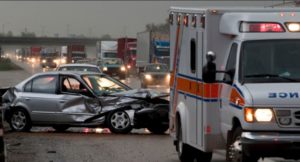
Speeding is defined as exceeding the posted speed limit or driving too fast for present road conditions.
Speed limit signs posted on roadways are there for a reason - to help ensure all motorists are safely operating their vehicles.
When drivers obey posted speed limits, it usually enables them to maintain control of their vehicles, safely navigate roads and quickly respond with enough time to avoid many accidents.
However, many drivers insist on ignoring state speed-related laws. These driver’s irresponsible actions routinely cause or contribute to car accidents, truck crashes, motorcycle collisions or even pedestrian accidents in New Jersey.
CAUSES OF SPEEDING ACCIDENTS
Speeding decreases a driver’s ability to safely navigate curves or steer around objects in the roadway, extends the distance necessary to stop a vehicle, and increases the distance of travel while the driver reacts to a dangerous situation. Many can agree that excessive speeding can be dangerous. They overlook the seriousness of the offense and the risk posed to themselves and others when they are in a rush or disregard the speed limit.
Speeding while driving is an act of negligence often resulting in tragic and costly consequences. Car accidents caused by speeding may result in serious personal injuries and wrongful deaths as well as substantial damage to property. Speeding while driving contributes to nearly one-third of all fatal car accidents, resulting in an average of more than 13,000 deaths each year.
THE DANGERS OF SPEEDING WHILE DRIVING
Speeding reduces the amount of control the driver has over the vehicle and the amount of reactionary time a driver has to avoid an accident. Reaction time is measured as the time it takes a driver to recognize that they need to brake and the amount of time that it takes a driver to move their foot to the brake pedal.
According to the AAA Foundation for Traffic Safety, speeding nearly triples the odds of being in a car accident. In addition to causing more accidents, speed-related crashes often result in more severe injuries than those occurring at lesser speeds. The crash energy absorbed by the human body increases exponentially as speeds increase. For example, when a car increases speed from 40 to 60 mph, the energy released in a crash more than doubles.
In bicycle and pedestrian accidents, modestly higher speeds can mean the difference between life and death. A pedestrian struck by a vehicle travelling 39 mph is twice as likely to suffer severe injuries and twice more likely to die than if they were struck at a speed of 31 mph.
RISK FACTORS CONTRIBUTING TO SPEEDING ACCIDENTS
Studies indicate that gender and age may play a role in the likelihood of being involved in a fatal speed-related car accident. Recent studies show that 37% of young male drivers involved in fatal crashes were speeding. Additionally, male drivers between the ages of 15 to 24 years are 42% more likely to be involved in a fatal speed-related crash than their female counterparts.
Road rage and other forms of aggressive driving such as running red lights and failure to yield are other risky driving behaviors associated with speeding. Data shows drivers under the influence of drugs or alcohol speed more often. Speeding with a blood alcohol content of 0.08% or higher more than doubles a driver’s chance of being involved in a fatal car accident. Also, those who speed regularly report lower use of safety systems such as wearing seatbelts in motor vehicles or wearing helmets on motorcycles.
INJURED IN A SPEEDING ACCIDENT? CALL US TODAY
Negligent driving, including speeding, puts everyone on the road at risk. It is essential that measures be taken promptly to preserve evidence and enable physicians or other expert witnesses to thoroughly evaluate any injuries.
If you or a loved one is a victim of a high-speed car accident, call our accident lawyers at the office of O’Connor, Parsons, Lane & Noble. We will send someone out to examine the scene and vehicle involved. You can simply Contact us online or call 1-908-928-9200 or 1-800-586-5817 for a free no obligation consultation.
